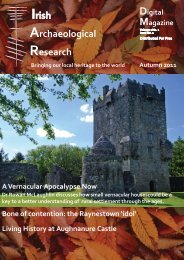Irish Archaeological Research Digital Magazine
Irish Archaeological Research Digital Magazine
Irish Archaeological Research Digital Magazine
You also want an ePaper? Increase the reach of your titles
YUMPU automatically turns print PDFs into web optimized ePapers that Google loves.
Lessons in a Lost Landscape<br />
The unwritten; indeed unspoken history of rural Ireland in recent centuries does not feature prominently in<br />
discourses about <strong>Irish</strong> history and politics. Yet, as the poet Seamus Heaney points out in a number of his works, a<br />
sense of prehistory has always existed, in silence, alongside historical narratives. The countryside contains little<br />
evidence of the battles, rebellions and treaties that continue to preoccupy our constructs of <strong>Irish</strong> identity. This is in<br />
stark contrast to the landscape itself, which is vividly thronged with the physical remains of a vernacular, traditional<br />
world; a way of life that could celebrate continuity from the stone‐age to the 21st Century.<br />
Traditional things tell us about the world in a way that historical sources cannot. They should not be lost because of<br />
transient economic circumstances, fashions or a generalised non‐specific fear of the old. Buildings, and their<br />
distribution in the landscape, express people’s interactions with the environment most eloquently. As it stands,<br />
however, we must fear that the countryside is on a self‐destructive course at present. Distributed settlement may<br />
well be tradi�onal and reflected in road infrastructure―hence the way the landscape is perceived. But new<br />
buildings have had so many negative impacts on the integrity of the countryside that few could argue that they<br />
provide a sustainable answer to the demand for rural housing. The answer, to me, seems to point towards a return<br />
to traditional houses. I mean that literally; thousands of these buildings could be restored and updated for modern<br />
needs, which would be a very valuable exercise if best practices (such as reversibility and clarity) were followed.<br />
Even if this were impossible, new buildings must take many more cues from traditional building materials and<br />
practices. In doing so, we would be able to continue to celebrate the special character of the <strong>Irish</strong> landscape long<br />
into the future. In a world that valued the past unequivocally, this would be common practice.<br />
The <strong>Irish</strong> landscape is currently being ravaged by the fallout from an economic recession caused by a burst<br />
speculative property bubble. Ghost estates proliferate and unfinished or uninhabited new‐builds can be found in<br />
abundance. It is not comforting to think that even in a derelict state, traditional buildings often appear more<br />
pleasing and less obtrusive than these latter‐day constructions... alas, how dreadful will these new buildings appear<br />
to our grandchildren’s generation?<br />
Text and Figure 1 copyright Rowan McLaughlin 2012<br />
Email: r.mclaughlin@qub.ac.uk<br />
Advertise here<br />
Your Company, Product or Service can<br />
feature here, see inside back page for<br />
details.<br />
<strong>Irish</strong> <strong>Archaeological</strong> <strong>Research</strong> Issue 2 Jan 2012<br />
Advertise here<br />
Your Company, Product or Service can<br />
feature here, see inside back page for<br />
details.<br />
34



